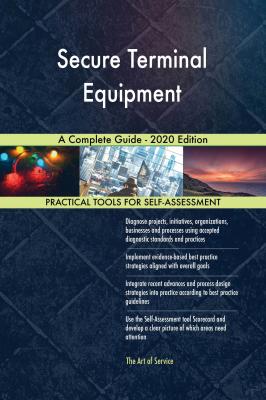ТОП просматриваемых книг сайта:
Secure Terminal Equipment A Complete Guide - 2020 Edition. Gerardus Blokdyk
Читать онлайн.Название Secure Terminal Equipment A Complete Guide - 2020 Edition
Год выпуска 0
isbn 9781867458623
Автор произведения Gerardus Blokdyk
Жанр Зарубежная деловая литература
Издательство Ingram
<--- Score
14. How do you build the right business case?
<--- Score
15. Have the customer needs been translated into specific, measurable requirements? How?
<--- Score
16. What are the rough order estimates on cost savings/opportunities that Secure Terminal Equipment brings?
<--- Score
17. Are audit criteria, scope, frequency and methods defined?
<--- Score
18. Scope of sensitive information?
<--- Score
19. How does the Secure Terminal Equipment manager ensure against scope creep?
<--- Score
20. Has a high-level ‘as is’ process map been completed, verified and validated?
<--- Score
21. Is there a Secure Terminal Equipment management charter, including stakeholder case, problem and goal statements, scope, milestones, roles and responsibilities, communication plan?
<--- Score
22. Is the Secure Terminal Equipment scope manageable?
<--- Score
23. Have all basic functions of Secure Terminal Equipment been defined?
<--- Score
24. How do you gather requirements?
<--- Score
25. How do you manage changes in Secure Terminal Equipment requirements?
<--- Score
26. Are required metrics defined, what are they?
<--- Score
27. Who is gathering information?
<--- Score
28. What baselines are required to be defined and managed?
<--- Score
29. How did the Secure Terminal Equipment manager receive input to the development of a Secure Terminal Equipment improvement plan and the estimated completion dates/times of each activity?
<--- Score
30. Are there any constraints known that bear on the ability to perform Secure Terminal Equipment work? How is the team addressing them?
<--- Score
31. What are the tasks and definitions?
<--- Score
32. Has a project plan, Gantt chart, or similar been developed/completed?
<--- Score
33. What are the record-keeping requirements of Secure Terminal Equipment activities?
<--- Score
34. What is the scope of Secure Terminal Equipment?
<--- Score
35. How are consistent Secure Terminal Equipment definitions important?
<--- Score
36. What intelligence can you gather?
<--- Score
37. How often are the team meetings?
<--- Score
38. Who is gathering Secure Terminal Equipment information?
<--- Score
39. What would be the goal or target for a Secure Terminal Equipment’s improvement team?
<--- Score
40. What is the context?
<--- Score
41. How was the ‘as is’ process map developed, reviewed, verified and validated?
<--- Score
42. What are the dynamics of the communication plan?
<--- Score
43. What happens if Secure Terminal Equipment’s scope changes?
<--- Score
44. Are accountability and ownership for Secure Terminal Equipment clearly defined?
<--- Score
45. Is there a critical path to deliver Secure Terminal Equipment results?
<--- Score
46. Are resources adequate for the scope?
<--- Score
47. What are the Roles and Responsibilities for each team member and its leadership? Where is this documented?
<--- Score
48. Do you have a Secure Terminal Equipment success story or case study ready to tell and share?
<--- Score
49. Are different versions of process maps needed to account for the different types of inputs?
<--- Score
50. What is in the scope and what is not in scope?
<--- Score
51. Is there a clear Secure Terminal Equipment case definition?
<--- Score
52. Is Secure Terminal Equipment linked to key stakeholder goals and objectives?
<--- Score
53. How would you define the culture at your organization, how susceptible is it to Secure Terminal Equipment changes?
<--- Score
54. What constraints exist that might impact the team?
<--- Score
55. Is the current ‘as is’ process being followed? If not, what are the discrepancies?
<--- Score
56. Is the work to date meeting requirements?
<--- Score
57. Has the improvement team collected the ‘voice of the customer’ (obtained feedback – qualitative and quantitative)?
<--- Score
58. What are the requirements for audit information?
<--- Score
59. What is out-of-scope initially?
<--- Score
60. How do you gather Secure Terminal Equipment requirements?
<--- Score
61. Is the Secure Terminal Equipment scope complete and appropriately sized?
<--- Score
62. Is the improvement team aware of the different versions of a process: what they think it is vs. what it actually is vs. what it should be vs. what it could be?
<--- Score
63. What scope do you want your strategy to cover?
<--- Score
64. Has everyone on the team, including the team leaders, been properly trained?
<--- Score
65. How do you catch Secure Terminal Equipment definition inconsistencies?
<--- Score
66. Are there different segments of customers?
<--- Score
67. What is in scope?
<--- Score
68.

